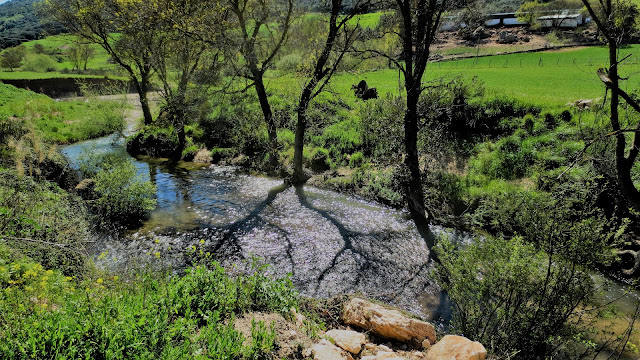THE BROSQUE The lands of the Trías de Antequera are located north of the municipality, and within them, framed between the gorges of the Hoz de Marín and the Guadalhorce gorge, we find the area known as El Brosque, a vulgarism derived from the word forest and that shows the type of vegetation prevailing in the area for centuries. It is a hilly terrain, with continuous ups and downs due to the existence of what are commonly known as "holes" of dimensions ranging from tens to hundreds of meters. The karstification of the plasters that form the terrains geologically known as Antequera Triads have made the site of El Brosque what it is, a spectacular field of dolinas resulting from the dissolution of the evaporític rocks that form it. These dolinas are endorreic basins, geomorphological structures that lead water to the lowest point, where the sink that connects the surface to the underground aquifer is located. These dolinas are available next to each other, and some of them even form seasonal lagoons because their sinkholes are plugged up by accumulating water rather than allowing it to leak into the subsoil. The vegetation of these mountains consists of numerous endemisms caused by the severe mountain climate and the composition of the soils in which they develop, with high magnesium content due to the outcrop of the dolomites. In the places of maximum development of vegetation we find the mixed forests of holm oaks (Quercus rotundifolia), quejigos (Quercus faginea) and maples (Acer monspessulanum); as well as in the extensive repopulation forests formed by carrascos pines(Pinus halepensis). The predominant vegetation in the area are holm oaks (Quercus rotundifolia), accompanied by whining(Quercus faginea) in the coldest and coldest areas. In the absence of these holm oaks, it will be the Mediterranean scrub that takes its place, consisting mainly of retamas (Retama sphaerocarpa), tomillos (Thymus zygis subsp. gracilis), rosemary (Rosmarinus officinalis), aulaga (Ulex parviflorus), albaidas (Anthillis cytisoides) and improves (Thymus mastichina). But, in addition to this, the natural vegetation of El Brosque is combined in mosaic form with the various crops that take advantage of the goodness of an unscayed terrain with abundant plains. In this way, it is common to find the slopes of dolinas occupied by natural vegetation and the background of the same cereal crops. These flatr areas are known as sloths. Due to the characteristics of natural vegetation, combined as a mosaic with crops, the most abundant species will be rabbits (Oryctolagus cuniculus), hares (Lepus granatensis), partridges (Alectoris rufa), foxes (Vulpes vulpes) and wild boars (Their scofa). In addition to all of them, it is also common to have deer (Cervus elaphus), especially in the berrea season, which, although they are held in more protected and less traveled areas such as the Hoz de Marín or the Guadalhorce Gorge, come here in search of food. In addition to mammals, reptiles are also abundant, such as the ocellate lizard(Lacerta lepida), Iberian lizard(Podarcis hispanica) or the colilarga lizard (Psammodromus algirus).




THE GUADALHORCE GORGE This spectacular place is located in the northwestern area of the municipality of Villanueva del Rosario, forming the border with the municipality of Antequera. Through this narrow passage, the Guadalhorce transits from its high course, near its birth, to the vegas of Archidona and Antequera. Due to the composition, easily erodable and susceptible to be dissolved by water, of the materials that make up the Antequera Triad, this impressive fluvio karstic throat has been created. In addition, geologically other materials of interest also emerge in the area, with composition and origin very different from these. These are the ofitas, subvolcanic rocks whose origin lies in an embossing of magmatic material that was enclosed between the plasters and clays of the Tries during the alpine orogeny and which led to the elevation of the entire bética mountain range from the seabed to the position that we currently find it. It is therefore a vestige of the clash of plaques that led to the emergence of the Andalusian region. The dominant vegetation in the area is the Mediterranean scrub, because due to the steep slopes and the scarce soil that can retain its slopes, it is not possible to develop tree vegetation. Thus, both theretama ( Retama sphaerocarpa) and coscojas (Quercus coccifera) and lentiscos (Pistacea lentiscus) are abundant, and even holm oaks(Quercus rotundifolia) of low weight. Larger trees are held around the river course in the form of a cordon of riparian vegetation that, at specific points, reach to create gallery forests formed bywhite poplars ( Populus alba), ash trees(Fraxinus angustifolia), elms (Ulmus minor) and willows (Salix alba). In the most degraded areas of the river, we will find more bushy vegetation composed of mimbrals (Salix fragilis), tarajes (African Tamarix), zarzales (Smilax aspera), etc. In this area the most emblematic species are the deer(Cervus elaphus) which, together with the mountain goats (Capra pyrenaica), find in this place a natural protection that allows the development of important herds. It is of particular interest the visit of this place in the time of berrea. In addition, as for birds, it is of interest the presence of abundant insectivorous and raptor species, which take advantage of the few walls of limestone rocks that we find crowning its slopes to nest. Such is the case of the eagle-azor perdicera (Aquila fasciata).

























No hay comentarios:
Publicar un comentario